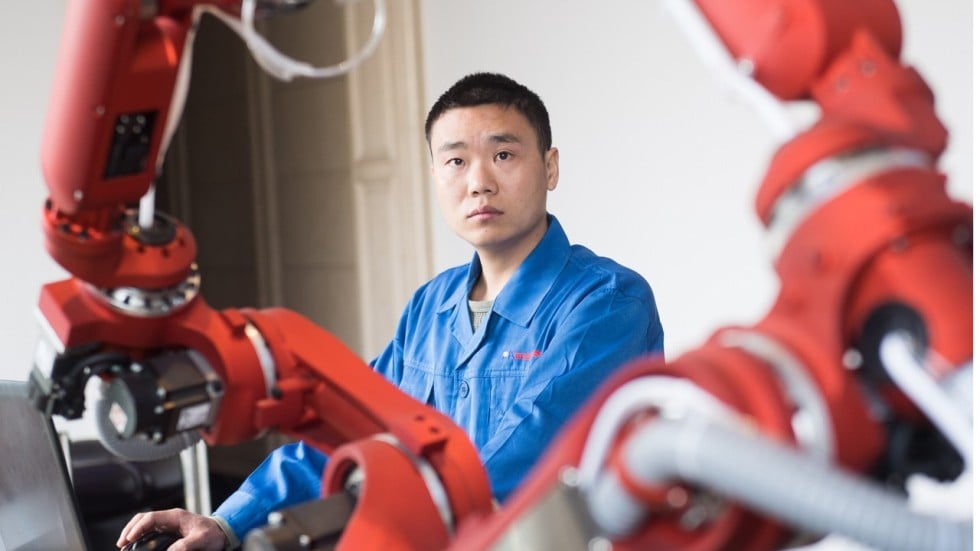Yingzhi Yang
 This strategy, known as the Chinese version of the Fourth Industrial Revolution, had initially raised concerns in the United States and European Union because of the mainland’s goal to wean itself off importing a range of technologies from leading foreign suppliers. “Instead of moving ahead with the progressive market-based reforms announced at the Third Plenum in 2013, state planners are unfortunately falling back on the old approach of top-down decision-making,” Jörg Wuttke, the president of the European Union Chamber of Commerce in China, said in a report.
This strategy, known as the Chinese version of the Fourth Industrial Revolution, had initially raised concerns in the United States and European Union because of the mainland’s goal to wean itself off importing a range of technologies from leading foreign suppliers. “Instead of moving ahead with the progressive market-based reforms announced at the Third Plenum in 2013, state planners are unfortunately falling back on the old approach of top-down decision-making,” Jörg Wuttke, the president of the European Union Chamber of Commerce in China, said in a report.
The Mercator Institute for China Studies, a German think tank, described the strategy as “a forceful and smart challenge to the leading economies of today”.
That initiative, however, has proved to be prescient as China faces a potential trade war with the United States after US President Donald Trump announced plans to impose tariffs worth US$60 billion against goods imported from the mainland.
White House trade adviser Peter Navarro said the tariffs will be levied on products in the 10 areas identified in the “Made in China 2025” initiative.
Here are some salient points about that strategy.
When did the initiative take effect?
The plan became effective immediately after Li’s presentation.
“We will implement the 'Made in China 2025' strategy, seek innovation-driven development, apply smart technologies, strengthen foundations, pursue green development and redouble our efforts to upgrade China from a manufacturer of quantity to one of quality,” Li said in his 2015 annual government work report.
How will the Trump administration’s tariff plan impact the strategy?
Despite advances it has made in hi-tech industries, China still depends on foreign technology transfer to push forward its own innovation agenda and next-generation manufacturing goals. As such, analysts said US tariff measures could hurt the implementation of China’s 2025 goals.
What are the 10 sectors covered by the strategy?
1) Next-generation information technology, including cybersecurity.
2) High-end numerical control tools and robotics, which provide China with greater manufacturing efficiency as labour costs rise.
3) Aerospace equipment, which shows China’s determination to be a world leader in outer space exploration.
4) Ocean engineering equipment and hi-tech ships, signifying maritime security implications of China’s territorial claims in the South China Sea and the East China Sea.
5) Advanced railway equipment, which shows how advanced China’s high-speed railway systems have become.
6) Energy-saving and new energy vehicles, which highlights China’s goal to replace traditional petrol vehicles with those that use alternative fuel.
7) Power equipment, which are part of China’s implementation of clean power.
8) Agricultural machinery, which represents China’s advances in producing large tractors and high-performance combines.
9) New materials, which include materials like graphene and nano materials.
10) Biomedicine and high-performance medical devices, which includes China’s development of advanced chemicals and medical equipment.
How is China implementing the plan?
The Chinese government is investing vast resources, including subsidies, loans and bonds, to support domestic hi-tech enterprises and encourage more Chinese firms to expand overseas and acquire foreign firms with cutting-edge technologies.
The total “Made in China 2025” is likely to exceed US$1.5 billion. Besides central government funding, Chinese local authorities have committed more than US$1.6 billion between 2016 and 2020.
What has China achieved so far?
Initial positive results include advances in large aircraft manufacturing, semiconductor technologies, new material, aircraft engine and gas turbine, 5G mobile network equipment and new energy vehicles, according to Miao Wei, the Minister of Industry and Information Technology.
The government has also established five national manufacturing innovation centres and 48 provincial manufacturing innovation centres. China aims to set up around 40 national manufacturing innovation centres by 2025.
No comments:
Post a Comment